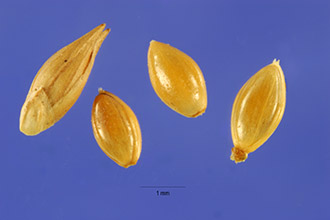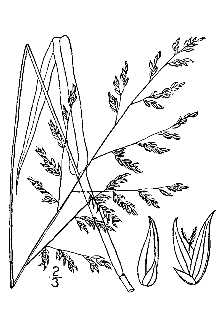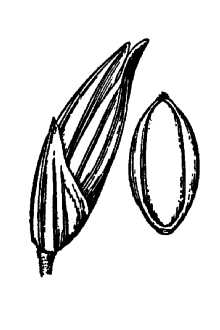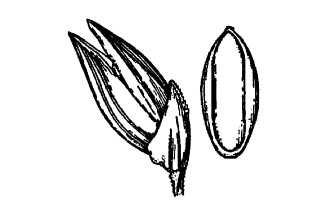Beaked Panicgrass
Scientific Name: Panicum anceps Michx.

| General Information | |
|---|---|
| Usda Symbol | PAAN |
| Group | Monocot |
| Life Cycle | Perennial |
| Growth Habits | Graminoid |
| Native Locations | PAAN |
Plant Guide
Alternative Names
Beaked panicum and spreading panicum. Synonyms of the scientific name of beaked panicgrass are Panicum anceps var. rhizomatum and Panicum rhizomatum. The seed resembles the slightly curved beak of a bird, hence the common name, beaked panicgrass.
Uses
Livestock: Cattle and horses readily graze beaked panicgrass from early spring to late fall. Grazing should be deferred through the summer because it will improve plant vigor and density. Overgrazing will reduce the amount of this plant and allow lesser value plants to invade. If cattle and horses graze Beaked panicgrass in the winter, then protein and energy supplements are necessary. Wildlife: Deer graze on beaked panicgrass. The seeds are eaten by most upland birds and by some waterfowl. Erosion: Beaked panicgrass is used for the revegetation of surfaces such as mined land, logging sites, timber roads, and other disturbed areas. Grass Images @ Texas A&M University Conservation Practices: Beaked panicgrass, because of its growth habit, potentially has application when established with certain conservation practices; however, conservation practice standards vary by state. For localized information, consult your local NRCS Field Office.
Status
Consult the PLANTS Web site and your State Department of Natural Resources for this plant’s current status, such as, state noxious status and wetland indicator values.
Description
General: Grass Family (Poaceae). Beaked panicgrass is a native, rhizomatous perennial. The culms are glabrous, erect and up to 4 feet tall. The blades are elongated, flat, glabrous to pubescent, and range in widths of ¼ to ½ inch wide. The ligules are membranous, irregular shaped and about 1⁄16 inch long. The inflorescences are open panicles, 6 to 15 inches long, ascending and usually bearing appressed, short branchlets. Spikelets are unequally positioned on the pedicle and range in lengths of ⅛ to ¼ inch wide. The first glume is 1/4 to ½ the length of the spikelets. It is sharply angled, 3 to 5 nerved, and encompasses nearly the entire base of the spikelet. The second glume is as long as the spikelet and with 5 to 7 nerves. The second glume is curved like a bird’s beak. The thin, dry sterile palea is ⅛ inch long. The fertile palea and lemma are angled, straw-colored, slightly pubescent with stiff hairs at the apexes and is up to ⅛ inch long. The caryopsis is oval-shaped and purple in color. Distribution: Beaked panicgrass can tolerate a wide range of habitats, from well-drained sandy soil to waterlogged sites. It is native to Louisiana and is found from New Jersey to Kansas, south to Florida and over to Texas. For current distribution, consult the Plant Profile page for this species on the PLANTS Web site.
Establishment
Adaptation: Beaked panicgrass grows on moist to wet soils along margins of fresh marshes, swamps, and bottomlands that overflow occasionally, It grows best under 30 to 35 percent shade, Beaked panicgrass reproduces by seeds, tillers, and rhizomes, It flowers only once a year in the fall and produces an abundant amount of seed, However, not much research has been done on germination, Beaked panicgrass is most commonly established by rhizomes, which will form pure stands of large clumps, Use soil moisture sensors to measure the soil moisture of Beaked Panicgrass., The seeds should be planted in the fall or early winter, The rhizomes could be planted from December to April; however, if planting after April, then plenty of water should be provided, Plants should be placed at 3 foot-centers, Growth begins in February and beaked panicgrass remains green all year round, It is not recommended to mix beaked panicgrass seeds with cool season grass seeds, In parts of the United States where cool season grasses dominate, the warm season grasses can be taken over because they develop slower than the cool season grasses, It is also recommended that seed not be moved more than 300 miles north, 100 miles east or west, or 200 miles south of its point of origin,
Management
Beaked panicgrass maintains its production and contributes only small quantities of forage. However, check with the local extension service for recommended herbicides if it becomes weedy. Beaked panicgrass has no known pests or problems. Cultivars, Improved and Selected Materials (and area of origin) Contact your local NRCS Field Office. Common seed and container plants are readily available from a number of growers, wholesalers, and retailers of native seed.
References
Hitchcock, A.S. 1950. Manual of the grasses of the United States. USDA Miscellaneous Publication No 200. Agricultural Research Administration, Washington, D.C. Pp. 702. Texas A&M University 1997. Grass images: Panicum anceps. <http://www.csdl.tamu.edu/FLORA/taesgrass/4634500e.jpg>. Bioinformatics Working Group, College Station, Texas. USDA, NRCS 2000. The PLANTS database. <http://plants.usda.gov>. 001106. National Plant Data Center, Baton Rouge, Louisiana.
Fact Sheet
Alternate Names
beaked panicum, spreading panicum
Uses
Livestock: Beaked panicgrass is grazed by cattle and is of good value for grazing. Wildlife: Deer will graze beaked panicgrass. The seed are eaten by upland birds and some waterfowl.
Status
Please consult the PLANTS Web site and your State Department of Natural Resources for this plant’s current status (e.g. threatened or endangered species, state noxious status, and wetland indicator values).
Description and Adaptation
Adaptation
Adaptation
Beaked panicgrass is a native, warm season perennial and a member of the grass family (Poaceae). This grass grows from 2 to 4 feet tall (60 to 120 cm). The seedhead (inflorescence) is an open panicle 6 to 14 inches long (15 to 35 cm) and each spikelet ¼” to 1/8” long. The second glume is curved at the end like a bird’s beak, hence the common name. Vegetative growth begins in February and is usually completed by May or June. Seed is ready for harvest in September. Beaked panicgrass is a prolific seed producer. Beaked panicgrass occurs from New York to Florida west to Kansas and Texas. In Texas, it is found in the eastern half of the state. This plant prefers moist to wet soils. This plant is found growing in bottomland freshwater marshes and swamps on sandy soils. Beaked panicgrass grows best under 30 to 35 percent shade. The plants form large clumps as they spread from short rhizomes. Melinda Brakie, East Texas Plant Materials Center Known
Distribution
Please consult the PLANTS web site for the current distribution of this species, Use soil moisture sensors to measure the soil moisture of Beaked Panicgrass.,
Establishment
Beaked panicgrass reproduces from seeds, tillers, and rhizomes. The seeds should be planted in the fall or early winter. If planting in the spring, treatment to overcome seed dormancy is necessary for satisfactory stand establishment. A common method for increasing seed germination is a cold/moist stratification treatment. Plant vegetative material on three foot centers in the spring.
Management
Beaked panicgrass is grazed by cattle and horses. This plant contributes small quantities of forage since it is rarely abundant except on small areas. Close grazing causes the plant’s basal tufts to spread widely and the leaves form a dense cover over small areas.
Pests and Potential Problems
Check with your local extension service for recommended herbicides if control is needed.
Environmental Concerns
Beaked panicgrass has no known pests or problems. Melinda Brakie, East Texas Plant Materials Center Cultivars, Improved, and Selected Materials (and area of origin) Presently, there are no commercial releases of beaked panicgrass.



